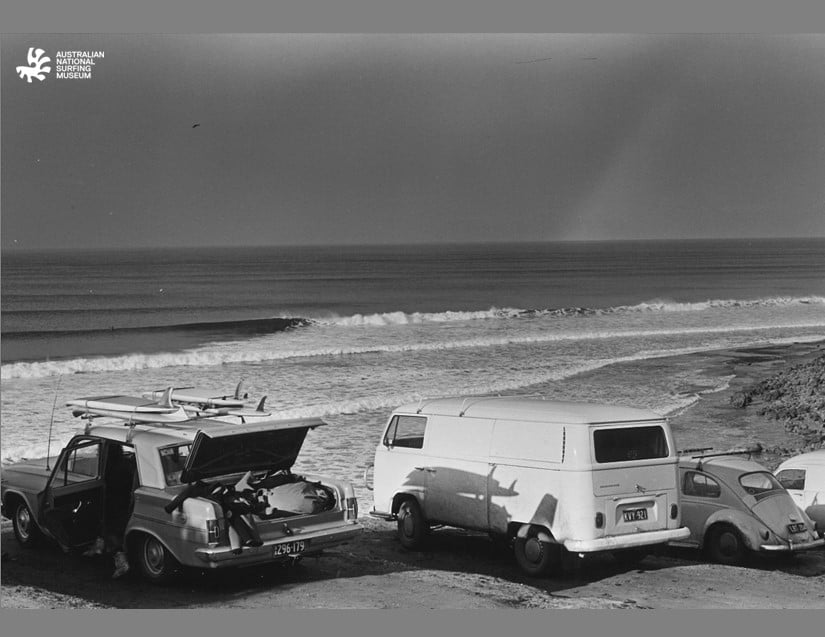FROM THE FRYING PAN INTO THE FIRE
As the 1960s came to a close, the times were a changing, there was revolution in the air. It was a period of dramatic social change, everything was being questioned, and social norms were being turned on their heads. The summer of love had come and gone, and surfers were squarely part of a counter culture movement. Country soul was the feeling many surfers wanted to embrace, a return to more simple living, being self-reliant and surfing wilderness locations. Eastern religions were being explored and Timothy Leary’s advice to “turn on, tune in, and drop out” was being embraced by many.
In 1970 the 5th World Surfing Championship at Bells Beach was tipped into this boiling pot of new ideas and changed expectations, the mix was not a happy one, people were conflicted and struggled to resolve the idea of structured contests and free thinking self-expression .
The competition very nearly didn’t happen despite the huge amount of work put into the event by organizers. The Australian Surfing Association did everything they could only to have some of the leading surfers talk the event down claiming “Surfing is not about competition”. Leading figures Ted Spencer and David Nuuhiwa arrived at Bells, had a look around, and bailed from the contest. Some surfers gave mixed messages claiming that competitions were uncool, only to then pull on coloured jerseys and paddle out to compete.
deneme bonusu veren bahis siteleri 2024
Plans were well advanced when event organisers ran out of money as they scrambled to finalise preparations for the event. Victorian Premier Sir Henry Bolte made an emergency payment of $22,000 to ensure the contest went ahead. Significant changes were made on site at Bells to provide some of the infrastructure needed for the competition, changes that were not entirely popular with surfers
When the contest kicked off it was evident that things were not exactly going to plan. Surfers hit the headlines, but for all the wrong reasons. Drugs were found in one competitor’s room and there was an altercation between a competitor and the local publican’s wife. In the water the Australian surfers had been expected to dominate, with previous champion Nat Young and local star Wayne Lynch being seen as contest favourites. But it was an almost unknown Californian Rolf Aurness who was the stand out surfer, riding more refined equipment. Aussie surfers were caught out riding short wide surfboards that were less well suited to the surf.
Then the surf ran out at Bells. With the finals yet to be run the contest was moved down the coast to Johanna beach. Surfers and local dairy farmers mingled in the carpark as the contest progressed out on the beach break banks. Rolf Aurness won the event from 1964 world champ Midget Farrelly, Peter Drouyn, Reno Abellira, Keone Downing and Nat Young. The women’s final was run at Skenes Creek and was won by American Sharon Webber.
Surf journalist Drew Kampion was moved to describe the event as “The death of all contests” which was perhaps a bit harsh. The world championships were held again in 1972 in San Diego but that event descended into chaos. The amateur world championship became less relevant as pro surfing took centre stage. As troubled as the contest may have been, a legacy remained.
The 5th World Surfing Championship was a huge boost to the nascent surf industry in Torquay. The world’s best surfers visited Torquay and Bells, peoples horizons expanded, new design ideas filtered into the minds of local surfboard shapers, International networks were established, and people realised it might be possible to make a living as a surfer. It was a dramatic turning point and marked a significant shift in how surfing was perceived. For some surfers the event represented a fork in the road, some eschewed the competition scene, while others embraced the opportunities surfing contests and a freshly energised surfing industry presented.
deneme bonusu 2024
Pic Simon Buttonshaw Bells Beach © courtesy Bryan Hughes
See more articles
PEOPLE & PLACE
In looking to refurb and update the museum one of the themes we will be exploring is People and Place. There is certainly a LOT locally to celebrate, a pretty epic place, steeped in surfing history, with a raft of interesting characters . . . I love this photo taken...
TURNING POINTS – THE BOARD THAT CHANGED THE SURFING WORLD
Simon Anderson’s Thruster is The Most Significant Design Innovation of the past 100 years, ushering in a new era of wave shredding performance and eventually becoming the most copied board design in history. Over the past 50 years, the majority of surfboard design...
SECRET SURFING HISTORY – FINAL WAVE
An old saying goes: “Believe none of what you hear, and only half of what you see.” It’s not bad advice these days considering some of what goes on with the internet. This though is a story of one of the most iconic images from Australian surfing history, and how...




